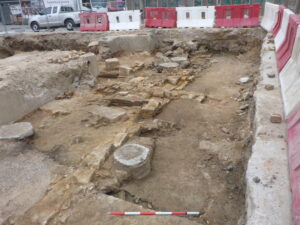
Historical excavations, Phillip Street Parramatta
Client: Coronation Property
Location: Parramatta NSW
Date: 2017 – 2022
Services provided
· Historical archaeological permit obtained under the Heritage Act 1977
· Aboriginal test excavations
· Historical test excavations
· Aboriginal Cultural Heritage Assessment
· Aboriginal Heritage Impact Permit obtained under the National Parks and Wildlife Act 1974
· Historical archaeological salvage excavations and monitoring
· Historical archaeological salvage report and artefact analysis
· Heritage interpretation plan addendum
Background
Coronation Property undertook this large project requiring both Aboriginal and historical heritage services and permits for works to proceed in several stages.
The project was complex due to work within the Parramatta Sand Sheet, which is listed as an ‘Ancient Aboriginal and Early Colonial Landscape’ on the NSW Heritage Register. The sand body comprises a layered depositional terrace above the Parramatta River’s normal water level and is thought to have been laid down by a long series of flood events. The terrace exists on either side of the Parramatta River between Charles and Alfred Streets, and into the eastern edge of Parramatta Park. Much of the sand body forms a levee on the southern side of the Parramatta River, just above the 1:100 year flood zone. Thermoluminesence dating suggests that the layers were deposited between 50,000-58,000 years ago.
The project also contained historical complexity in that part of the site is listed on the Parramatta Local Environmental Plan 2011 (Former St Andrew’s Uniting Church, hall and potential archaeological site No. I736). Also listed as Archaeological Management Units (AMU) Nos. 3022 and 3084 as part of the Parramatta Archaeological Management System. While AMU 3022 is identified as having as little or no potential to contain intact subsurface deposits, AMU 3084 is identified as having exceptional archaeological research potential. A convict hut is also recorded within the study area.
Outcome
Biosis obtained heritage permits and excavations were completed allowing the development to move forward with bulk excavation. Development in the lot which contained the heritage listed item and potential convict hut was successfully avoided.
Test excavations revealed the Parramatta Sand Sheet was present in the majority of test pits and a total of 28 Aboriginal stone artefacts were identified.
During monitoring and salvage, Biosis identified three 1840’s cottages which consisted of sandstone and sand stock brick wall footings, bases of fireplaces and a toppled chimney. A quadruple cesspit with two phases of construction was identified, which have been shared between two of the cottages. Rubbish pits were also excavated in the yards of the cottages and contained artefacts used in every day household activities such as alcohol bottles, crockery and sewing items.
